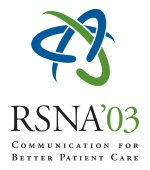Abstract:
HTML
Purpose: 1) to determine the discrepancy rate in interpretation of cervical
spine x rays for trauma and compare differences in specialty groups, 2) to
audit image quality and performance of c-spine series obtained in a trauma
setting, 3) to suggest guidelines and standards based on problems observed.
Methods and Materials: Research Ethics Board approval was obtained. C-spine
trauma x ray series in 302 consecutive children from April 2002 to February
2003, initially read by general/body radiologists were re-read by
neuroradiologists blinded to previous reports. Discrepancies were recorded as
major (which would affect patient care) and minor (which would not affect
patient care). Additional imaging studies (CT and/or MRI available in 130
children) were used as the gold standard. In patients with no CT or MRI, an
independent neuroradiologist's opinion was used as the standard for comparison.
Radiographs of the c-spine were further analysed into: 1) optimal , when the
ACR standards were met , or 2) suboptimal, when they did not meet ACR standards
for performance of cervical spine radiographs in children
Results: 10 major discrepancies and 22 minor discrepancies were found. Most
major discrepancies were due to interpretation of findings at the C1/C2 level.
In 130 patients, CT and/or MR studies had been obtained. In 80 (26%) children,
suboptimal x rays had been obtained. These were due to suboptimal odontoid
views, incomplete evaluation of C7/T1 or due to overlying artifacts. Factors
for suboptimal quality included age < 5 years, the presence of a neck
collar, suboptimal positioning on the trauma board and the presence of multiple
other trauma care personnel stressing priorities in their areas.
Conclusion: Major discrepancies in interpretation of c-spine trauma x rays
between neuroradiologists and body radiologists occured in 3.3% (10 children).
Though this is small it seems to mainly arise from interpretations of findings
at C1/C2. This error rate can be reduced by targetting quality assurance
educational programmes at this region and by lowering the threshold for use of
targetted CT for C1/C2 in very young children. Meeting technical quality
standards for cervical spine radiography in the trauma setting was a problem in
26% of children. This could be reduced by re-educating technologists and
co-ordinating activities with other trauma care personnel. (This work was supported by the Medical
Imagining Award, University of Toronto.)
Questions about this event email: manohar.shroff@sickkids.ca
Shroff MD, M,
An Audit of Cervical Spine Radiographs in Children with Acute Trauma. Radiological Society of North America 2003 Scientific Assembly and Annual Meeting, November 30 - December 5, 2003 ,Chicago IL.
http://archive.rsna.org/2003/3108144.html

